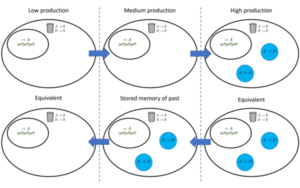Join us as a Masters or PhD student: Mechanisms for storing memory in cellular droplets
Required experience in the following methods:
statistical physics, 3D reaction diffusion models, critical behavior around bifurcations
Work with:
- Dr. Tyler Harmon | Tel: +49 (351) 4658 1216 | Email: TylerHarmon@ipfdd.de
- Prof. Dr. Jens-Uwe Sommer | Tel: +49 (351) 4658 750 | Email: Sommer@ipfdd.de
where: Leibniz Institute for Polymer Research Dresden (Leibniz-Institut für Polymerforschung (IPF) Dresden), Germany
Project description:
Biomolecular condensates are a newly defined class of organelle in the cell. In contrast to the classical picture of a cellular organelle, there is no membrane separating the inside from outside. Instead, they form through the physics of proteins phase separating into droplets similar to oil demixing from water. One of their primary functions is expected to be as reaction chambers where enzymes and substrates are localized into volumes separated from the rest of the cell. One advantage to using droplets over membrane-bound organelles is their ease of assembly and disassembly. When no longer needed the cells can dissolve the droplets.
In this project we will build a minimal model for how cells could have a controlled hysteresis in droplet formation. In short, whether droplets are thermodynamically stable is dependent on if droplets already exist. This can be described as a way for cells to store memory of previous events or conditions to analyze later. This will be accomplished by choosing chemical reactions that create positive feedbacks. One such possible feedback is an enzyme that converts the droplet material from a weakly phase separating state into a strongly phase separating state. In this way, once a droplet forms, energy is expended making it even more stable. This project will be focused on exploring the different mechanisms that cells could be using to produce hysteresis. The larger scale view of where this project fits into is a general study to build a library of all the ways chemical reactions could be used in collaboration with droplets to impact cell function and signaling.
 The key tasks for the project are
The key tasks for the project are
- Finding hysteresis loops in non-linear differential equation systems for droplets with chemical reactions.
- Studying numerically under what conditions they form.
- Finding limiting cases where we can estimate their onset.
- Extrapolating these results to different types of chemical feedbacks.
Current news by our research groups
Agnes Toth-Petroczy Group,Anthony Hyman Group
CD-Code is now published in Nature Methods
 CD-CODE is now published in Nature Methods. It is a “living database” that we designed for fast…
CD-CODE is now published in Nature Methods. It is a “living database” that we designed for fast…
Computational Postdoc or PhD student (m/f/d) in protein evolution and biomolecular condensates
The Toth-Petroczy lab is an interdisciplinary research group at MPI-CBG and CSBD that studies protein evolution. Applications will be reviewed on a rolling basis until the position is filled. The Max Planck Institute of Molecular Cell Biology and Genetics (MPI-CBG) and the Center for Systems…
We are hiring a Software Developer
The Toth-Petroczy lab is an interdisciplinary research group at MPI-CBG and CSBD that studies protein evolution. Applications will be reviewed on a rolling basis until the position is filled. The Max Planck Institute of Molecular Cell Biology and Genetics (MPI-CBG) and the Center for…
Simon Alberti Group,Alf Honigmann Group,Anthony Hyman Group,Marcus Jahnel Group
A role for RNA in Stress Granules assembly
Stress granules are membraneless compartments formed by phase separation of specific molecules upon exposure to cellular stress such as oxidative stress, heat shock, or osmotic stress. The Alberti, Jahnel, Honigmann, and Hyman labs published a study in cell highlighting the role of RNA in the…
Filament formation by the translation factor eIF2B regulates protein synthesis in starved cells
Aminoacyl-tRNA synthetases (aaRSs), the enzymes responsible for coupling tRNAs to their cognate amino acids, minimize translational errors by intrinsic hydrolytic editing. Here, we compared norvaline (Nva), a linear amino acid not coded for protein synthesis, to the proteinogenic, branched valine…
Moritz Kreysing Group,Simon Alberti Group,Anthony Hyman Group
Condensation regulates translation
New insights into the influence of Ded1p condensation on translation comes from the Hyman, Alberti and Kreysing labs. The study published in Cell is entitled "Condensation of Ded1p Promotes a Translational Switch from Housekeeping to Stress Protein Production".
Graphical abstract: